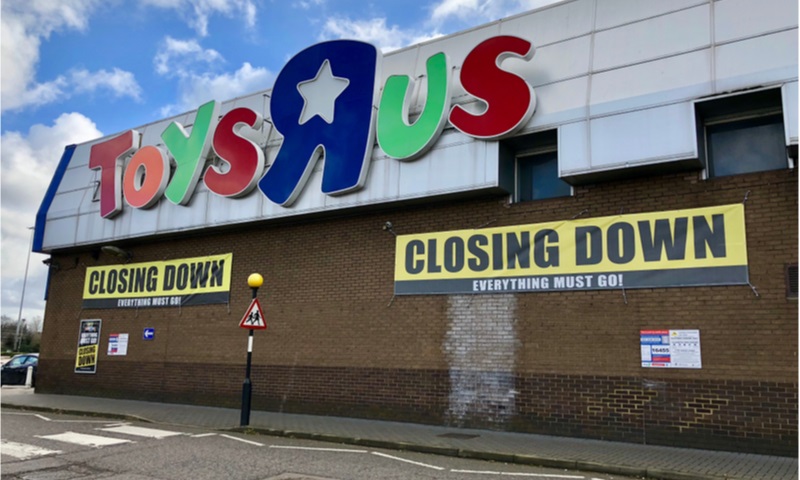Toys R Us closing: just a tiny part in a big (and sad) commercial real estate trend

After 70 years in business, one of the most beloved children retail stores in America is going out of business. That’s right: Toy R Us is closing. And so are their other brands Babies R Us and Kids R Us. This situation has been going on for a while. Last September, Toys R Us filed for bankruptcy hoping to stanch their $5 billion debt and regroup somehow, but it was too late. With a terrible holiday season, Toys R Us announced in March they are closing all of its 735 brick and mortar stores and online operation.
Once the nostalgia passes and we analyze the whys to Toys R Us closing, it becomes apparent that this is just a part (a tiny one) of a big and sad commercial real estate trend where brick and mortar stores are consistently having a hard time maintaining business.
First, the classic retail stores got the convenience competition of big box stores like Target and Walmart, who basically have a row for every type of product existent. What is more convenient for you; going to 3 different retail stores to get 3 different products or finding them all in one big store? Then, came price competition from places like Amazon, who doesn’t have to deal with high rent costs and some taxes. Their cost storing and sending products throughout the country - infimum compared to 100+ commercial real estate rent - allowed them to be extra aggressive and further deepen the dagger through brick and mortar stores’ hearts – and will possibly get even tougher now when the launch of Amazon HQ2 sets a new commercial real estate trend.
If you think we’re being alarmist; it’s not just Toys R Us closing. The examples of this commercial real estate trend of shrinking brick and mortar supply and demand are abundant:
Footlocker reported a loss of $49 million in the fourth quarter of 2017 and plans to close 110 stores in 2018. Starbucks Corporation is planning on closing every single one of its 379 Teavana stores. Best Buy Mobile has already announced closing all of its 250 stores nationwide – cell phone products will still sell at their 1,000 big box stores. Sears Holding is closing 64 Kmarts and 39 Sears retail stores. Michael Kors has yet to announce exactly how many of its stores will close but it’s said to be something between 100 to 125 unities. And remember how omnipresent Radio Shack was? They used to have 1,000 stores and have 70 now. Might close those too.
Is this irreversible? Will it take the commercial real estate market to crumble for us to see brick and mortar stores thriving? Not at all. It’s all a matter of efficiency. Aside from the obvious investment in an online presence and online operation - can the brick and mortar partner with innovative services like postmates or uber eats to instantly deliver products, thus being more attractive than online shopping? - these retail stores can’t escape the fact that rent is and will continue to be a big problem for them. More and more companies should be looking to real estate as an integral part of their overall strategy, rather than an outsourced service they use every now and then. Even if they don’t rent because they own the locations they are in; all companies sit atop a property and that has a value. The evaluation of their real estate portfolio – rent or owned – needs to be made on a regular basis and in consonance with its marketing strategies. It’s ok to have flagship stores like the huge Toys R Us at Times Square in New York as a marketing ploy, but the cost of rent is usually paid by all the other store's profit, so this whole math has to be done together with a sound real estate department who will be responsible for knowing when and how to buy and sell or rent properties.
Speaking of marketing: rebranding is always good too. If competition has a better price and ease, you need to invest in the quality and specificity of your service. Narrow the spotlight of communication as much as you can, add some in-store service that might drive consumers to it. Not to say retail stores should sell one type of product only, but focus, diversity and quality of a service contrasts with the general “we have it all” attitude and raises your market value as a trusted source for something. When McDonald’s started serving chicken sandwich and nuggets in the 1980’s, people didn’t stop going to KFC, right?
A proof that Toys R Us Closing is not a sign of an upcoming extinction of all brick and mortar stores - but of efficiency in the supply and demand of commercial real estate - is what’s going on at GAP Inc. Although they are closing 200 retail stores (between GAP and Banana Republic), they have announced they will open 270 new retail stores of two of their growing brands: Old Navy and Athleta.
So, there is hope. Even though beloved brands like Toys R Us, Babies R Us and Kids R Us have closed and others are struggling, it doesn’t mean they will all vanish. However: yes, time is sensitive to your favorite brick and mortar stores. So, if you, as a consumer, is feeling uneasy about the whole thing, here’s one action you should take before it’s too late: spend any gift cards you have from your favorite retail stores as soon as you can, before they become just a piece of plastic – Toys R Us coupons and gift cards will still be honored until the end of April. Consuming and sharing your love will go a long way to help your favorite brick and mortar stores adapt and survive the natural selection of supply and demand.